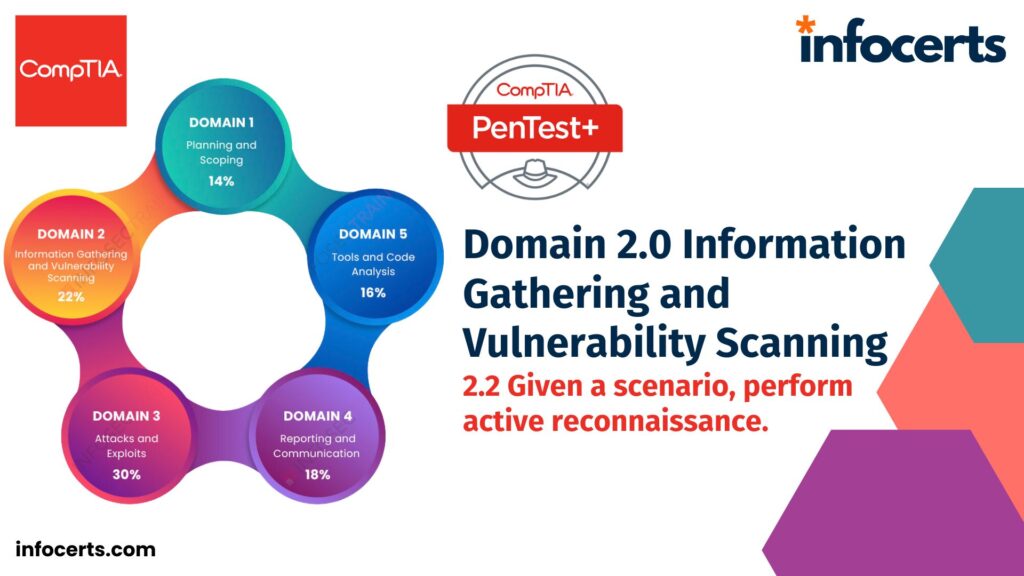Domain 2.0 Information Gathering and Vulnerability Scanning
Active reconnaissance is an essential aspect of cybersecurity, allowing professionals to gather critical information about potential targets. From discovering hosts and services to identifying vulnerabilities, active reconnaissance lays the groundwork for effective penetration testing and security measures. In this guide, we’ll explore various techniques and tools for active reconnaissance as outlined by CompTIA Pentest+.
Enumeration
Enumeration involves systematically identifying and documenting information about a target. This includes:
– Hosts: Discovering all devices on a network, including their IP addresses.
– Services: Identifying services running on these hosts, such as FTP, SSH, or HTTP.
– Domains: Determining domain names associated with the target.
– Users: Finding user accounts on systems.
– URLs: Identifying web addresses related to the target.
Website Reconnaissance
Understanding a target’s web presence is crucial. Techniques include:
– Crawling Websites: Using tools like [Burp Suite](https://www.comptia.org/certifications/pentest) to map out the structure of a website.
– Scraping Websites: Extracting useful data from websites, often done with Python libraries like BeautifulSoup.
– Manual Inspection of Web Links: Exploring links to uncover hidden or overlooked pages.
– Robots.txt: Checking this file for instructions on what web crawlers are allowed to access.
Packet Crafting
Crafting custom packets allows testers to analyze network behavior. [Scapy](https://www.comptia.org/certifications/pentest) is a powerful tool for this purpose.
Defense Detection
Understanding how defenses operate is crucial for bypassing them. Key aspects include:
– Load Balancer Detection: Identifying load balancers used to distribute network or application traffic.
– Web Application Firewall (WAF) Detection: Discovering WAFs protecting web applications.
– Antivirus and Firewall Detection: Recognizing these security measures and finding ways around them.
Tokens
Tokens are used for authentication and authorization. Actions include:
– Scoping: Defining the scope of tokens, such as what systems or resources they grant access to.
– Issuing: Generating tokens for users.
– Revocation: Disabling or revoking tokens when necessary.
Wardriving
This involves scanning for wireless networks while driving through an area, aiming to identify vulnerabilities in wireless security.
Network Traffic
Analyzing network traffic provides insights into communication patterns and potential vulnerabilities. Techniques include:
– Capturing API Requests and Responses: Recording interactions between applications.
– Sniffing: Collecting and analyzing packets transmitted over a network.
Cloud Asset Discovery
Discovering assets hosted on cloud platforms like AWS or Azure is vital for understanding an organization’s infrastructure.
Third-party Hosted Services
Identifying services hosted by third-party providers helps in understanding potential attack surfaces.
Detection Avoidance
To avoid detection, testers need to understand how their activities might be spotted by defenders.
Now that we’ve covered these techniques, it’s important to remember that proficiency in active reconnaissance requires hands-on experience and continuous learning.
Our Company, Secure Tech, offers training programs to help IT professionals master these skills. To enroll in our CompTIA Pentest+ course, call us at +91 70455 40400.
Active reconnaissance is a cornerstone of cybersecurity, enabling professionals to identify and mitigate vulnerabilities before they can be exploited by malicious actors. By mastering these techniques, cybersecurity professionals play a crucial role in safeguarding digital assets and protecting against cyber threats.

